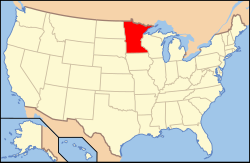| Wine region | |
 | |
| Official name | State of Minnesota |
|---|---|
| Type | U.S. state |
| Year established | 1858 |
| Years of wine industry | 1977-present |
| Country | United States |
| Sub-regions | Alexandria Lakes AVA, Upper Mississippi Valley AVA |
| Climate region | Continental |
| Total area | 87,014 square miles (225,365 km2) |
| Grapes produced | Chambourcin, Chardonnay, Concord, Delaware, Edelweiss, Frontenac, Frontenac gris, Geisenheim, Gewürztraminer, Itasca, La Crescent, La Crosse, Leon Millot, Malbec, Marechal Foch, Marquette, Riesling, Sabrevois, Seyval blanc, St. Croix, St. Pepin, Syrah, Vidal blanc, Vignoles, Zinfandel[1] |
| No. of wineries | 40 |
Minnesota wine refers to wine made from grapes grown in the U.S. state of Minnesota. Minnesota is part of the largest American Viticultural Area (AVA), the Upper Mississippi River Valley AVA, which includes southwest Wisconsin, southeast Minnesota, northeast Iowa, and northwest Illinois. The state also has a smaller designated American Viticultural Areas, the Alexandria Lakes AVA. Minnesota is a very cold climate for viticulture and many grape varieties require protection from the winter weather by being buried under soil for the season. Minnesota is home to extensive research on cold-hardy French hybrid and other grape varieties.
The Minnesota Grape Growers Association (MGGA) is a statewide organization that promotes grape growing and wine making in the state and also in cold-hardy climates. Minnesota is home to the International Cold Climate Wine Competition (ICCWC) hosted annually in partnership between MGGA and University of Minnesota. This is the only wine competition solely dedicated to the promotion of quality wines made mainly from cold-hardy grape varieties. In 2014, the 6th annual competition saw 284 wines entered from 59 commercial wineries in 11 states. Awards were based on blind tastings by 21 expert judges, who include enologists, wine writers, restaurateurs, retailers, and wine educators.
YouTube Encyclopedic
-
1/3Views:7 5151 49239 072
-
Cold hardy grapes feed local wine industry
-
Helping Minnesota Hops Grow: Conducting on-site research trials with Minnesota hops producers
-
Knowing when to harvest your grapes
Transcription
We are at the University of Minnesota Horticulture research center, at the Minnesota Landscape Arboretum and this is where we conduct our grape breeding. We are primarily focused on wine grapes and making wine in Minnesota is a relatively new venture. We have been at that since 1978 and have introduced four varieties so far: the Frontenac, Frontenac Gris, La Crescent and Marquette. And these varieties really form the backbone for the local wine industry in our state and also in the surrounding region. A study was done in 2007, which is the latest study that we actually have, which showed that there are probably about 1,200 acres of grapes now in the state and the contribution to the economy was about 36 million dollars back in 2007. So that is kind the scale we're on right now. Usually I would say in the last several years we have been adding about 3 to 5 new wineries per year. Our varieties of cold hardy grapes are grown really all across the northern tier of the United States from the Midwest tier across to New England. There are wineries from Maine, New Hampshire, Vermont down through Connecticut, Massachusetts through parts of New York and Pennsylvania Michigan, Wisconsin all that grow and rely on the varieties of grapes that we have developed here at the University of Minnesota. Woodland Hill Winery is family-owned and we take extreme pride in our wine and our experience. We grow two different varieties of Cold Hardy grapes. We grow the newest variety called Marquette and that we make our Vinny's red from, which we named after our dog, and then we have La Crescent, which is our largest planting that we have in our vineyard. You can always look at a U of M cluster and kind of know it is a U of M grape by this trailer that comes off the side. Very pretty. They all have that little second; more so pronounced than other grapes that we grow. When we didn't have all the U of M varieties and stuff to work with, the wines were maybe not quite as exceptional as they are now and so we as an industry in Minnesota have had to kind of battle our way out of that. And you know on a daily basis people are like wow, ya know, this is really good. Myself and others have won awards, you know, not only locally but throughout the nation, so I mean it is not like we're a we're just an anomaly or anything we're kind of here to stay I think.
History
The first modern winery in Minnesota, Northern Vineyards Winery, opened in 1977. In 1973, the first recorded vineyard in Minnesota was planted by David Bailly at Alexis Bailly Vineyard in Hastings, MN. In 1978, Minnesota and Alexis Bailly Vineyard celebrated the production of the first wine commercially produced of 100% Minnesota grapes.[2] In 1997, only 3 wineries existed in Minnesota.[3] Today over 40 wineries have commercial operations in Minnesota.[4]
Influence of Elmer Swenson
Horticulturalist Elmer Swenson created commercially successful, cold-climate varieties in Minnesota including the Edelweiss and St. Croix grapes. Oenology programs at the University of Minnesota developed the Frontenac grape variety in 1995, and continue to research new hybrids and techniques for grape growing in the state and other cold climate regions.[1]
See also
References
- ^ a b "Minnesota: Appellation Profile". Appellation America. 2007. Archived from the original on September 2, 2013. Retrieved November 26, 2007.
- ^ "Alexis Bailly Vineyard".
- ^ "History". Minnesota Grape Growers Association. 2018.
- ^ "Locate a Winery". Minnesota Grape Growers Association. 2018.

